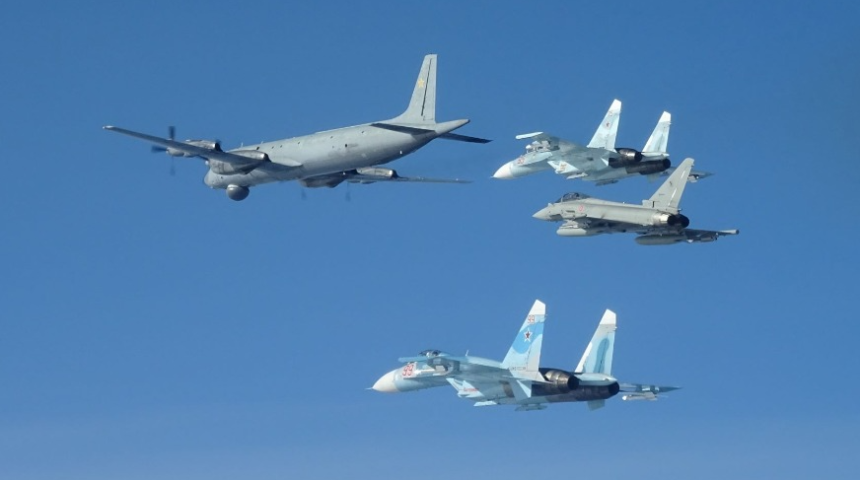NATO fighter jets shadowed Russian bombers and fighters during an “unusual peak of flights” over the North Atlantic, North Sea, Black Sea and Baltic Sea, yesterday.
Monday Mar. 29, 2021, was particularly busy for NATO fighters. According to the NATO Allied Air Command, its fighters, providing Air Policing at various locations along the borders of the Alliance, intercepted different groups of Russian military aircraft near NATO airspace in less than six hours.
“Intercepting multiple groups of Russian aircraft demonstrates NATO forces’ readiness and capability to guard Allied skies 24 hours a day, 7 days a week, 365 days a year,” said Brigadier General Andrew Hansen, Deputy Chief of Staff Operations at Allied Air Command, Ramstein, Germany, in a public release.
In the High North, Norwegian F-16s scrambled after radars spotted two groups of Russian military aircraft flying near Norway’s coast.
Полёт Ту-160 и Ту-142 в Северное, Норвежское и Баренцево море #bearnet pic.twitter.com/yjwQfeVguQ
— Записки охотника (@galandecZP) March 29, 2021
“The Norwegian jets intercepted two Tu-95 Bear bombers, which continued to fly south over the North Sea prompting the United Kingdom and Belgium to scramble Typhoon and F-16 fighters, respectively,” says the NATO statement, although the aircraft depicted in the photographs released by the Royal Air Force were Tu-142 “Bear-F” long-range maritime patrol reconnaissance and anti-submarine warfare aircraft
Which bear is which?🐻
There are three main variants of Russian Bears which are intercepted by @RAFLossiemouth #QRA:
Tu-95 Bear-H // Strategic Bombers
Tu-142 Bear-F // Maritime Recon & ASW
Tu-142 Bear-J // VLF Comms Relay
This thread will show you how to identify variants! 1/4 pic.twitter.com/IRiGFokIuo
— Dan Chorley (@DanChorley) March 29, 2021
The Belgian Air Force F-16s were also scrambled to respond to the Russian bombers presence over the North Sea. The Belgian Vipers have recently returned to full operational status after being grounded following an incident last month in which an F-16 experienced an engine problem taking off from Florennes.
“Lima Hotel Zero One” #LH01 and “Lima Hotel Zero Two” #LH02, two 🇧🇪#Belgium Air Force F-16’s, returning from a 🇷🇺#Russia 🐻 threat over the North Sea, pictured heading south over 🇳🇱the Netherlands about 15 minutes ago.#NLspot🇳🇱 #HaveGlass @Andy007_SR_A @haveVglass @air_intel https://t.co/uni9Bmeov8 pic.twitter.com/fhI5vImKA4
— Soesterberg Air Base Spotter (@EHSBspotter) March 29, 2021
Later in the day, the Norwegian F-16s intercepted two Tu-160 Blackjack bombers over international waters.
Turkish, Romanian and Bulgarian fighter aircraft were also scrambled track Russian aircraft operating in the Black Sea area. The types of Russian aircraft in this group have not been disclosed.
In the Baltic Sea, the Italian Air Force Eurofighter Typhoons deployed to Šiauliai, Lithunia, to support NATO Baltic Air Policing mission, were launched to identify a Russian Il-38 “Dolphin” (NATO reporting name “May”) ASW (Anti-Submarine Warfare) aircraft which was escorted by the F-2000s over the Baltic Sea flying into and out of Kaliningrad Oblast.
Interestingly, a photo of this intercept has been released by NATO Allied Air Command and shows the Russian Il-38 escorted by two Su-27 Flankers flying in “formation” with the Italian Eurofighters (one clearly visible in the photo, another one not visible, because it was the camera ship).
“The men and women at NATO’s two Combined Air Operations Centres in Uedem, Germany, and Torrejón, Spain, quickly responded to unidentified aircraft near the Alliance’s borders by launching fighters from Norway, the United Kingdom, Belgium, Italy, Romania, Bulgaria and Turkey to investigate and protect allied airspace”, Brigadier Hansen said, adding that NATO’s Air Policing mission is a “truly collective effort”.
Obviously, the Russian aircraft intercepted on Monday remained in international airspace near NATO airspace, and the interceptions “were conducted in a safe and routine manner”. However, as explained by NATO “Russian military aircraft often do not transmit a transponder code indicating their position and altitude, do not file a flight plan, or do not communicate with air traffic controllers, posing a potential risk to civilian airliners,” as happened a few years ago in the Baltic Sea, when an Il-20 almost collided with a civilian aircraft near Sweden.









